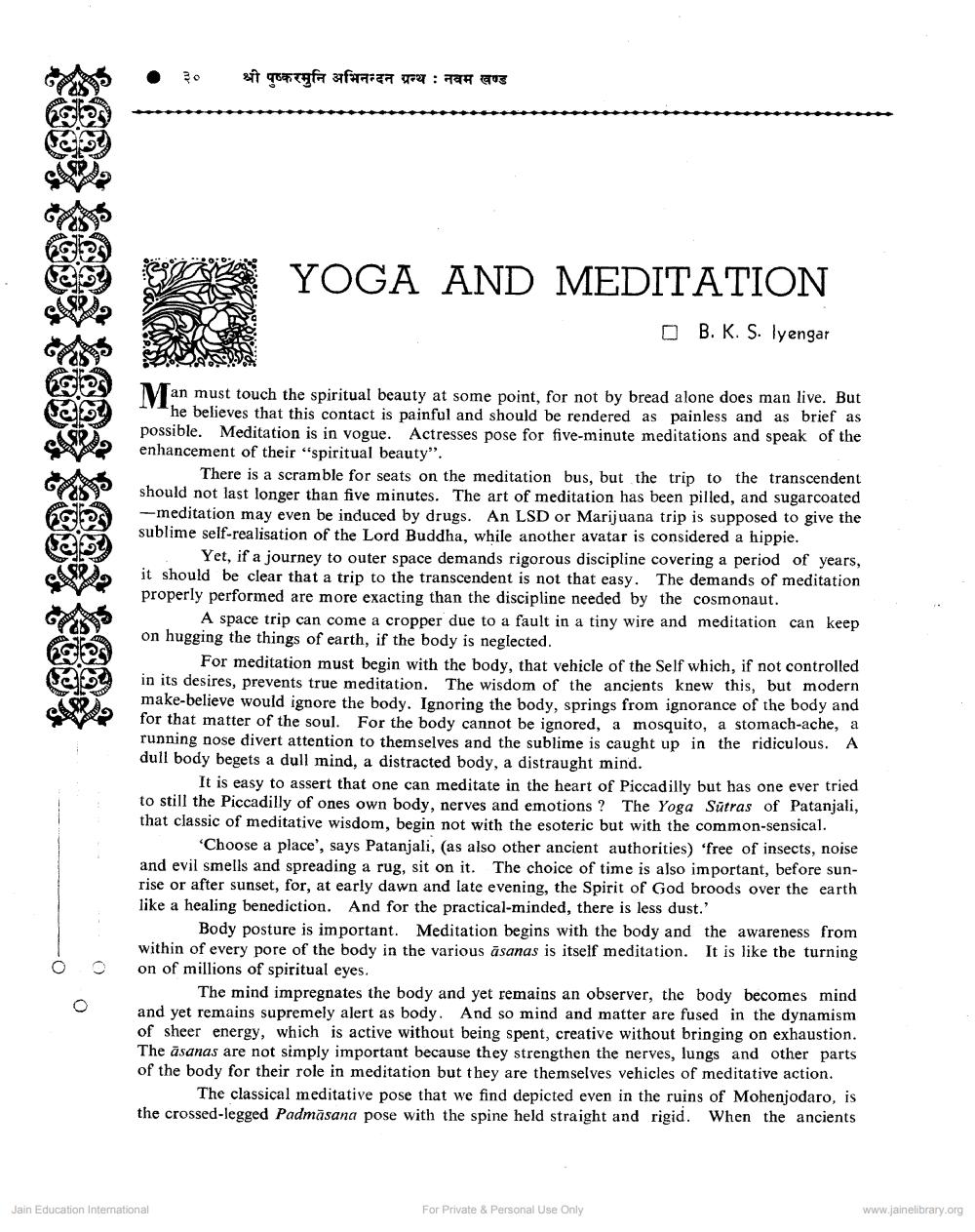________________
३०
श्री पुष्करमुनि अभिनन्दन ग्रन्थ : नवम खण्ड
* YOGA AND MEDITATION
B. K. S. Iyengar
M an must touch the spiritual beauty at some point, for not by bread alone does man live. But
he believes that this contact is painful and should be rendered as painless and as brief as possible. Meditation is in vogue. Actresses pose for five-minute meditations and speak of the enhancement of their “spiritual beauty".
There is a scramble for seats on the meditation bus, but the trip to the transcendent should not last longer than five minutes. The art of meditation has been pilled, and sugarcoated --meditation may even be induced by drugs. An LSD or Marijuana trip is supposed to give the sublime self-realisation of the Lord Buddha, while another avatar is considered a hippie.
Yet, if a journey to outer space demands rigorous discipline covering a period of years, it should be clear that a trip to the transcendent is not that easy. The demands of meditation properly performed are more exacting than the discipline needed by the cosmonaut.
A space trip can come a cropper due to a fault in a tiny wire and meditation can keep on hugging the things of earth, if the body is neglected.
For meditation must begin with the body, that vehicle of the Self which, if not controlled in its desires, prevents true meditation. The wisdom of the ancients knew this, but modern make-believe would ignore the body. Ignoring the body, springs from ignorance of the body and for that matter of the soul. For the body cannot be ignored, a mosquito, a stomach-ache, a running nose divert attention to themselves and the sublime is caught up in the ridiculous. A dull body begets a dull mind, a distracted body, a distraught mind.
It is easy to assert that one can meditate in the heart of Piccadilly but has one ever tried to still the Piccadilly of ones own body, nerves and emotions? The Yoga Sutras of Patanjali, that classic of meditative wisdom, begin not with the esoteric but with the common-sensical.
'Choose a place', says Patanjali, (as also other ancient authorities) 'free of insects, noise and evil smells and spreading a rug, sit on it. The choice of time is also important, before sunrise or after sunset, for, at early dawn and late evening, the Spirit of God broods over the earth like a healing benediction. And for the practical-minded, there is less dust.'
Body posture is important. Meditation begins with the body and the awareness from within of every pore of the body in the various asanas is itself meditation. It is like the turning on of millions of spiritual eyes.
The mind impregnates the body and yet remains an observer, the body becomes mind and yet remains supremely alert as body. And so mind and matter are fused in the dynamism of sheer energy, which is active without being spent, creative without bringing on exhaustion. The asanas are not simply important because they strengthen the nerves, lungs and other parts of the body for their role in meditation but they are themselves vehicles of meditative action.
The classical meditative pose that we find depicted even in the ruins of Mohenjodaro, is the crossed-legged Padmāsana pose with the spine held straight and rigid. When the ancients
Jain Education International
For Private & Personal Use Only
www.jainelibrary.org




